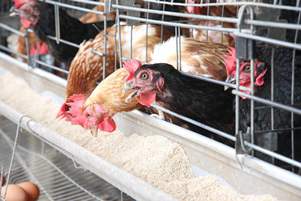Study: Antimicrobial resistance to Salmonella

A study was carried out to detect Salmonella spp. contamination on poultry and poultry environmental samples of layer farms, situated in Bareilly Uttar Pradesh to determine the antibiotic susceptibility profiles and serotype distribution of the isolates.
A total of 720 samples of egg, feed, water, cloaca, and faeces were collected and screened for the presence of Salmonella. 24 (3.3%) of the samples tested were found to be positive for Salmonella. Out of 180 eggs, 120 poultry feed samples, 120 poultry water samples, 120 faecal samples and 180 cloacal swabs, the isolation frequencies of Salmonella spp. were 3.3%, 2.5%, 3.3%, 2.5% and 4.4% respectively. Among the isolates, Salmonella Typhimurium was the predominant serovar.
The antibiogram testing revealed differential multi-drug resistance among Salmonella isolates in poultry and poultry environment samples. All the isolates were resistant to clindamycin, oxacillin, penicillin and vancomycin whereas sensitivity was recorded for ampicillin, enrofloxacin and colistin. As a result, the relatively high resistance among the bacteria present in poultry could pose public health and therapeutic problems to consumers as potential vehicles of resistant Salmonella foodborne infections.
Source: Renu Singh and co-workers, Central Avian Research Institute, Izatnagar U.P. , M. J. P. Rohilkhand University, Bareilly, Salim Ali Centre for Ornithology and Natural History, Coimbatore, IndiaA total of 720 samples of egg, feed, water, cloaca, and faeces were collected and screened for the presence of Salmonella. 24 (3.3%) of the samples tested were found to be positive for Salmonella. Out of 180 eggs, 120 poultry feed samples, 120 poultry water samples, 120 faecal samples and 180 cloacal swabs, the isolation frequencies of Salmonella spp. were 3.3%, 2.5%, 3.3%, 2.5% and 4.4% respectively. Among the isolates, Salmonella Typhimurium was the predominant serovar.
The antibiogram testing revealed differential multi-drug resistance among Salmonella isolates in poultry and poultry environment samples. All the isolates were resistant to clindamycin, oxacillin, penicillin and vancomycin whereas sensitivity was recorded for ampicillin, enrofloxacin and colistin. As a result, the relatively high resistance among the bacteria present in poultry could pose public health and therapeutic problems to consumers as potential vehicles of resistant Salmonella foodborne infections.
Source: Renu Singh and co-workers, Central Avian Research Institute, Izatnagar Uttar Pradesh. , M. J. P. Rohilkhand University, Bareilly, Salim Ali Centre for Ornithology and Natural History, Coimbatore, India













